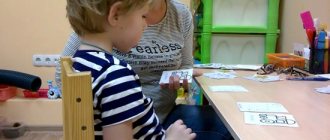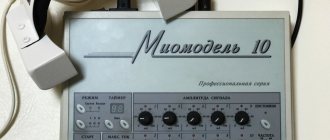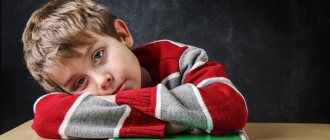Russia, Moscow State Budgetary Educational Institution Secondary School No. 760 Teacher-speech therapist Sorokina O.Yu.
Introduction
One of the leading lines of modernization of education is the achievement of a new quality of preschool education. This necessitates the development of modern correctional and educational technologies, updating the content of work with children with severe speech impairment and stuttering in combined preschool educational institutions.
Today, the problem of combining correctional and general developmental components in working with children with disabilities is relevant to ensure the possibility of maximizing their potential and correcting existing disorders.
The solution to this problem is possible through the development of a work program that integrates the content of complex and correctional programs in working with children with SLD.
The program represents a correctional educational system that ensures the formation of communication abilities, speech and mental development of preschool children with speech pathology, and their successful adaptation into a group of peers.
The “Program” is based on a psycholinguistic approach to speech activity, including semantic, syntactic, lexical, morphological and phonetic components, suggesting intensive and extensive paths of development and the formation of a “sense of language”.
Correction of manifestations of speech underdevelopment in children of senior preschool age, training in the skills of using coherent speech free from stuttering, as well as prevention of secondary disorders are provided.
The adapted program of the group speech therapist teacher is a local act of the State Budget Educational Institution Secondary School No. 760 of the combined type of the city of Moscow, developed in accordance with:
with the laws of the Russian Federation
Federal Law of December 29, 2012 No. 273-FZ “On Education in the Russian Federation”
with documents from the Ministry of Education and Science of the Russian Federation
- Order of the Ministry of Education and Science of the Russian Federation dated October 17, 2013 No. 1155 “On approval of the federal state educational standard for preschool education”
- Order of the Ministry of Education and Science of the Russian Federation dated August 30, 2013 No. 101 “On approval of the Procedure for organizing and implementing educational activities in the main general educational programs of preschool education”
with documents from the Federal Services
- Resolution of the Chief Sanitary Doctor of the Russian Federation dated May 15, 2013 No. 26
“On approval of SanPiN 2.4.1.3049-13 “Sanitary and epidemiological requirements for the design, content and organization of work in preschool organizations”
This work was developed based on the programs:
- The main general educational program of preschool education of the State Budgetary Educational Institution Secondary School No. 760 of a combined type in the city of Moscow.
- Approximate basic general education program for preschool education “From birth to school” (edited by N.E. Veraksa, T.S. Komarova, M.A. Vasilyeva)
When developing the work program, the following additional programs were also used:
- “Program of speech therapy work to overcome general speech underdevelopment in children.” Recommended by the Academic Council of the State Scientific Institution “Institute of Correctional Pedagogy of the Russian Academy of Education”. Moscow “Enlightenment” 2008 (author-compiler G.V. Chirkina);
- “Program of speech therapy work with children who stutter.” Recommended by the Academic Council of the State Scientific Institution “Institute of Correctional Pedagogy of the Russian Academy of Education”. Moscow “Enlightenment” 2008 (S.A. Mironova).
Chapter 1. Toria and the practice of accompanying children with disabilities
1.1.Characteristics of children with severe speech impairments.
General underdevelopment of speech (hereinafter GSD) is understood as a form of speech pathology in which the formation of each of the components of the speech system is disrupted: vocabulary, grammatical structure, coherent speech, sound pronunciation, with normal hearing and relatively intact intelligence. (T.B. Filicheva, G.V. Chirkina). Recently, there has been a tendency towards a progressive increase in various clinical manifestations of OHP. The group with severe speech impairments includes children with varying levels of general speech underdevelopment, often complicated by dysarthria, rhinolalia, and stuttering).
Disturbances in speech activity in children with ODD are multidimensional in nature, requiring methodological and organizational continuity in solving educational and correctional problems. The senior group for children with SLI includes children mainly with the second or third level.
Children with the second level of speech development communicate not only with the help of gestures and babbling words, but also with fairly constant, although phonetically and grammatically distorted, speech means.
The active vocabulary is represented by nouns, verbs and some adjectives and adverbs. Children rarely use pronouns, prepositions and conjunctions.
There are separate forms of inflection of words by numbers, genders, cases, verbs by tenses, often with a large number of errors.
Nouns are more often used in the nominative case, the use of indirect cases is random; verbs are used in the infinitive or in the 3rd person singular and plural present tense. In this case, the agreement of verbs with nouns is broken.
In children's speech there is a mixture of singular and plural verbs, past and present tense forms, and masculine and feminine past tense verbs. The neuter gender of verbs is not used.
The agreement of adjectives with other parts of speech is often disrupted.
Prepositions are replaced or omitted. Conjunctions and particles are not used.
There are attempts to find the desired grammatical form of the word, but more often than not they are unsuccessful. Word formation is not formed.
Passive dictionary. Children distinguish some grammatical forms, but this discrimination is unstable.
Children are able to differentiate between singular and plural forms of nouns and verbs; masculine and past tense verbs, focus not only on the lexical meaning, but also on meaningful morphological elements.
Understanding the number forms and gender of adjectives and the meaning of prepositions is only available in familiar situations.
Phrasal speech is formed. A large number of agrammatisms are observed.
Sound pronunciation is significantly impaired. The number of incorrectly pronounced sounds is 16-20 (S, S', Z, Z', Ts, Sh, Zh, Ch, R, R', L, L, T, T', D, D', G, G'). Replacement of hard consonants with soft ones and vice versa are typical. Vowels are not clearly articulated. There are sharp discrepancies between the isolated reproduction of sounds and their use in speech. The immaturity of sound pronunciation in children is clearly manifested when pronouncing words and sentences.
C log structure. Children correctly convey the sound composition of one-syllable words without a combination of consonants, but in many cases the repetition of two-syllable words fails.
Insufficient assimilation of the sound composition of words delays the formation of children's vocabulary and their mastery of grammatical structure.
Coherent speech comes down to listing events, actions and objects.
The third level of speech development is characterized by the presence of developed phrasal speech with pronounced elements of underdevelopment of vocabulary, grammar and phonetics. The structure of sentences is disrupted due to the omission and rearrangement of main and minor members.
The formation of the grammatical structure of a language is incomplete and is characterized by the presence of pronounced violations of coordination and control.
Word-formation activity is not sufficiently formed. Cognitive and speech abilities are poorly developed to explain the meanings of many words. Characterized by persistent and gross violations in the formation of words that go beyond the scope of everyday speech practice. There is a substitution of word formation operations with inflection. Characterized by inaccurate understanding and use of generalizing concepts and words with abstract and figurative meanings. There is a tendency towards multiple lexical substitutions.
Along with lexical errors, children also show a specific peculiarity of coherent speech in the form of a violation of the coherence and sequence of the story, semantic omissions of essential elements of the plot line, noticeable fragmentation of the presentation, violation of temporary and cause-and-effect relationships in the text.
Difficulties in reproducing words of different sound-syllable content are typical.
Sound pronunciation is characterized by inaccurate articulation of some sounds and unclear differentiation of them by ear.
Lack of phonemic perception is manifested in difficulties in identifying the first and last consonant, vowel sound at the end and middle of a word, selecting pictures whose names contain a given sound, and errors in determining the place of a sound in a word. Tasks for independently inventing words are not completed.
The fourth level of speech development is characterized by residual phenomena of underdevelopment of the lexico-grammatical and phonetic-phonemic components of the language system.
Children experience difficulties in reproducing words with complex syllabic composition and the sound content of words.
Sluggish articulation of sounds, lack of expressiveness of speech and unclear diction are typical.
The incompleteness of the formation of the sound-syllable structure, the mixing of sounds, the low level of differentiated perception of phonemes are an important indicator that the process of phoneme formation is not completed.
Individual violations of the semantic aspect of speech are observed. With a fairly diverse subject vocabulary, they do not accurately know and understand words that are rarely encountered in everyday speech practice; They do a poor job of choosing synonyms, antonyms, and related words.
There are errors in the use of genitive and accusative plural nouns and complex prepositions; violations in the agreement of ordinal numbers and adjectives with feminine and masculine singular and plural nouns. In coherent speech, it is difficult to convey a logical sequence, repeat episodes and use predominantly short sentences with little information.
In addition to the presence of speech underdevelopment, children with stuttering have become more common among children. Today, interest in the problem of stuttering is growing, and an international journal on stuttering is regularly published.
1.2. Characteristics of speech development disorders in children who stutter
Stuttering is a violation of the tempo and rhythm of speech of varying severity, caused by muscle spasms of the speech apparatus during speech and complicating the process of communication.
E.A. Dyakova, L.M. Belyakova, V.M. Shklovsky, Arutinyan L.Z. and others define stuttering as a complex psycho-physiological arousal associated with functional disorders of speech activity, namely the tempo-rhythm-intonation aspect of speech.
A mild degree is observed when independently producing a speech utterance, without affecting situations of communication with strangers, participation in joint games, various activities, and carrying out assignments related to the need for verbal communication.
The average degree is characterized by difficulties in communicating with strangers and refusal to participate in group games. Convulsions are observed in various parts of the speech apparatus during independent, question-answer and reflected speech.
A severe degree manifests itself in all communication situations, complicating verbal communication and collective activity of children, distorting the manifestation of behavioral reactions.
In children suffering from stuttering, with a normal volume of active vocabulary and sufficiently developed grammatical structure, speech is replete with inserted words and sounds: well, what’s his name, and, uh, a, etc. In independent statements there are unfinished sentences, inaccurate, approximate in meaning answers on questions.
Often stuttering is accompanied by accompanying or violent movements (eyelid twitching, blinking, finger tapping).
The use of short, monosyllabic answers is typical.
The ability to perform two types of activities simultaneously has not been developed, which is due to the peculiarities of the volume, distribution and switching of attention.
New material is absorbed more productively in the form of a game. The game allows the child to practice correct speech without much stress.
It is typical for children to perceive inanimate objects as living and endow them with speech, especially in story-based games with imaginative toys. There is a tendency to imitate adults: in the manner of standing, sitting, performing actions with objects and speaking. When copying adults, they repeat verbatim the lines, intonation, gestures, and facial expressions at the moment of the speech act.
Specific features of general and speech behavior are noted: increased impulsiveness of speech, weakness of volitional tension, delayed or advanced involvement in activities, instability of attention, lack of concentration, occurring against the background of rapid fatigue, increased exhaustion leading to various errors
The presence of children with stuttering in a group for children with speech disorders necessitates the development of an adapted work program that takes into account the specifics of working with this population.
Program for individual support of a child with disabilities, as part of an adapted educational program for children with speech disorders (OND, stuttering)
Chapter 2. Contents of the program for individual speech therapy support for a child with severe speech impairments in the senior group of a preschool educational institution
2.1. Goals and objectives of educational activities for the implementation of the work program
Program goals:
- elimination of stuttering
- creating conditions for the development of the child, eliminating manifestations of ODD,
- ensuring emotional well-being through the integration of educational content and the organization of interaction between subjects of the educational process.
Main goals:
The work program is aimed at:
Training and mastery of independent, stutter-free speech
Comprehensive development and correction of OHP in preschool children.
- creating favorable conditions for the development of children in accordance with their age and individual characteristics.
Strengthening psychophysical health, emotional well-being;
- ensuring cognitive, speech, social-communicative, and physical development of children in various types of children's activities;
- providing psychological and pedagogical support to the family
2.2 Principles and approaches to the formation of the Program
The work program of a speech therapist teacher is based on the following principles:
- principle of developmental education.
- the principle of humanization (recognition of the uniqueness and originality of each child, unlimited opportunities for the development of the personal potential of each child, respect for his personality).
- the principle of step-by-step correctional and educational work with a gradual increase in its intensity;
- The principle of gradualism in speech education determines the structure and organization of correctional and educational work.
- the principle of using gaming activities.
- the principle of integration of educational areas in accordance with the age capabilities and characteristics of children.
- the principle of supporting children's initiative in various activities;
- principle of formation of cognitive interests.
- complex thematic principle.
- building the educational process on age-appropriate forms of working with children.
2.3. Projected results of the program implementation
As a result of mastering the program it is expected:
- dynamics of individual development of children;
- correction of speech disorders and speech development of children:
- manifestation of motivation to exercise, attempts to plan (with the help of an adult) activities to achieve a goal;
- the use of words denoting the names of objects, actions, signs, states, properties, qualities;
- using words in accordance with the communicative situation;
- distinguishing word formation patterns and grammatical forms of words in impressive speech;
- the use in speech of the simplest types of complex sentences with coordinating conjunctions;
- retelling (with the help of an adult) a short fairy tale or story;
- compiling a descriptive story on the issues (with the help of an adult), focusing on toys, pictures, from personal experience;
- distinguishing by ear between undisturbed and disturbed sounds;
- mastery of simple forms of phonemic analysis;
- use of various types of intonation structures;
- parental participation in the educational process.
- creation of an active developmental environment aimed at self-realization of the child in activities specific to preschool age.
2.4. System of work of a speech therapist teacher.
The academic year in the combined group for children with severe speech impairment begins on September 1, lasts nine months (until June 30) and is divided into three periods:
- September – adaptation period and in-depth diagnostics (examination and filling out speech cards, monitoring the child in various situations: during routine moments, play situations, when communicating with adults and peers), individual work, as well as drawing up a work plan for the first half of the year.
- October, November, December, January – stage 1 of work (in January the results of the work for the first period are summed up, children’s speech development is diagnosed)
- February, March, April, May – stage 2 of work (in May the results of the work for the year are summed up)
- June – joint activities to consolidate developed speech skills (games and game exercises).
Speech therapy work with children with ODD complicated by stuttering is carried out individually, depending on the nature and severity of the speech defect, psychological and characterological characteristics.
Duration of continuous direct educational activities for children in accordance with SanPiN 2.4.1.3049-13 “Sanitary and epidemiological requirements for the design, content and organization of work in preschool organizations”:
- from 5 to 6 years - no more than 25 minutes.
Chapter 3. Program of individual support for a child with disabilities of the senior group, as part of an adapted program (ONP, stuttering).
3.1. Eliminating stuttering .
Speech therapy work is carried out individually, taking into account individual speech capabilities, character, severity of speech defect, psychological and characterological characteristics of children.
The main goal is to eliminate stuttering and prepare for independent communication.
During the learning process, children gradually acquire independent, stutter-free speech. This is achieved through a system of exercises to develop regulatory mechanisms and develop skills in using accessible forms of independent situational speech, followed by their complication and the transition to contextual speech.
Speech exercises are carried out in specially organized communication conditions regarding directly observed objects and actions with them. At the beginning of training, only organized speech is allowed, i.e. active independent speech of children is encouraged, directed and regulated by questions and instructions from a speech therapist.
In the process of correctional training, a gradual and feasible complication of speech forms occurs.
The acquisition of independent speech without stuttering should be facilitated by specific forms of vocabulary work, as well as work on phrases and stories.
The amount of speech practice is important when eliminating stuttering. It is necessary to gradually increase speech activity, cultivating attention and interest in speech.
The main task in speech therapy work is to improve the mechanisms of the linguistic level of speech activity.
Necessary:
learn to understand spoken speech in accordance with the parameters of the age norm; formulate the sound side of speech phonetically correctly; correctly convey the syllabic structure of words; be able to use simple common and complex sentences in independent speech, have the skills of combining them into a story, basic retelling and dialogue skills; master word formation skills: produce nouns from verbs, adjectives from nouns and verbs, diminutive and magnifying forms of nouns; use words of various lexical and grammatical categories (nouns, adjectives, verbs, adverbs, pronouns) in spontaneous communication, as well as formulate independent speech grammatically correctly in accordance with the norms of the language.
On individual GCD the following is carried out:
1) activation and development of differentiated movements of the organs of the articulatory apparatus;
2) preparation of an articulatory base for the production of missing sounds, their differentiation by ear and automation at the level of syllables and words.
3) the use of various techniques to ensure free speech communication.
In addition, work is being carried out to correct and develop:
-understanding of speech and lexical and grammatical categories;
-pronunciation side of speech;
-independent detailed phrasal speech;
In the process of work, speech restrictions are introduced with a subsequent increase and complication of speech forms.
This system is carried out in the following sequence:
- preparation for the regime of silence (September)
- silent mode; October –(1 week)
- whispered speech; October –(2 weeks)
- conjugate speech; October-November (4 weeks)
- reflected speech; November-December(4 weeks)
- question-answer speech; January – February (4 weeks)
- education of independent speech based on retelling material; March.
- education of independent speech based on the material of the story; April.
- education of independent spontaneous speech. May June.
3.2. Work to correct manifestations of general speech underdevelopment.
In the process of work, the following tasks are solved:
Formation of general speech skills:
- Formation and consolidation of the diaphragmatic type of physiological breathing, lengthening the exhalation by singing vowels and counting.
2. Teaching a calm short exhalation and a smooth long exhalation without speech accompaniment and with speech accompaniment, with lengthening the speech exhalation when pronouncing syllables, words, phrases.
3. Improving the acoustic characteristics of the voice (strength, pitch, timbre, intonation). Strengthening the soft attack of the voice.
Activation of vocabulary and development of lexical and grammatical means of the language:
- Teach children to listen to spoken speech. Learn the meanings of new words by deepening your knowledge on the topics: Vegetables. Garden. Fruits. Garden. Berries. Mushrooms. Autumn. Autumn forest. Migratory birds. Domestic animals and their young. Poultry. Winter. Signs of winter. Wintering birds. New Year. Winter fun. Winter sports. Wild animals and their young. Pets. Birds. Spring. Insects. Summer.
- Teaching children to understand the meaning of less productive and unproductive diminutive suffixes (-nick, -nits, -ink-, -in-, -its-, -ets-).
- Teaching the distinction between reflexive and non-reflexive verbs in impressive speech.
- Improving expressive speech, clarifying the meanings of words denoting the names of objects, actions, states, signs, properties and qualities.
- Improving skills in using singular and plural forms of masculine, feminine and neuter nouns in the nominative case and oblique cases. By topic: Vegetables. Fruits. Mushrooms.
- Teach the use of singular and plural verbs in the present and past tense in speech. By topic: Autumn. Cloth. Professions. Winter. Winter fun.
- Learn to convert 2nd person singular imperative verbs into 3rd person singular and plural present tense indicative verbs.
- Improve the skills of agreeing adjectives with masculine, feminine and neuter nouns in the singular and plural (wild, domestic animals and their cubs.)
- Improve your skills in using phrases that include cardinal numbers and nouns.
- Expand the ability to use the dialogical form of speech at the stage of question-answer speech.
- Learn to use possessive pronouns “my” - “mine” in independent speech in combination with masculine and feminine nouns.
- Teach methods of word formation: using nouns with diminutive suffixes and verbs with different prefixes (na-, po-, vy-)
- Learn to form relative adjectives with the meaning of correlation to food, plants, materials. Strengthen the skills of forming relative adjectives using productive suffixes (-ov, -ev, -in, -an, -yan).
- Learn to form the most common possessive adjectives, as well as adjectives using diminutive suffixes: -enk-, -onk-.
- Learn to use the most accessible antonyms (good - evil, high - low, etc.)
- Clarify the meanings of generalizing words. By topic: Dishes. Furniture. Family. Appliances. Trees. Transport.
- Learn to distinguish and highlight features in word combinations by purpose and questions: Which? Which? Which?; pay attention to the relationship between the ending of the question word and the adjective.
- Practice composing first two and then three forms of the same verbs (lie - lie - lie).
- Learn to change the form of verbs from the 3rd person singular to the form of the 1st person singular (plural) (go - go - go).
- Use the prepositions NA, UNDER, V, IZ, denoting the spatial arrangement of objects, in combination with the corresponding case forms of nouns.
- To consolidate the skill of using everyday verbs with a new lexical meaning, formed through prefixes that convey various shades of actions (moved in, left, drove up, moved out).
Correction of phonetic speech disorders:
- To clarify the pronunciation of vowels and consonants of early ontogenesis.
- To form the correct articulation of missing, disturbed sounds of late ontogenesis, their automation and differentiation.
- To develop the ability to carry out auditory and auditory-pronunciation differentiation of preserved sounds, and in the future - sounds with which correctional work was carried out.
4.Improve skills in reproducing words of various sound-syllable structures.
5. Strengthen the skill of correct pronunciation of sounds, their automation at the level of syllables, words, sentences.
Development of independent phrasal speech:
- Strengthen the skill of drawing up simple sentences on questions, on demonstration of actions, on pictures, on models:
- noun im. P. + agreed verb + direct object;
- noun im. P. + agreed verb + 2 verb-dependent nouns in indirect cases.
- Improve the skill of conducting a prepared dialogue (request, conversation, elements of dramatization).
- Learn to distribute proposals by homogeneous members.
Learn to compose the most accessible constructions of compound and complex sentences.
4. Learn to compose different types of sentences: - simple common ones of 5 - 7 words; - sentences with adversative conjunctions “a” and &ldquo






